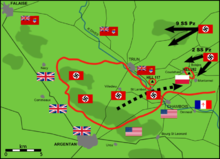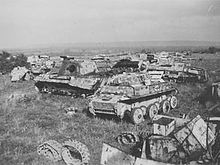Mont Ormel
| date | 19th bis 21st August 1944 |
|---|---|
| place | Normandy , France |
| output | Polish victory |
| Parties to the conflict | |
|---|---|
| Commander | |
| Troop strength | |
| 2 armored combat groups | Parts of several armored divisions |
The Mont Ormel [ mɔ͂ ɔʀmɛl ] is a 262 meter high elevation five kilometers east of Trun in Normandy . The hill was in the Second World War an important command post for the German and Allied forces during the Allied advance on the German Reich in August 1944 and was due to its height hill 262 , respectively. The elevated position allows an excellent view of the surrounding area around the municipalities of Chambois and Vimoutiers . After Operation Cobra , Hill 262 was a key position in the encirclement of the German 7th Army in the Falaise pocket .
Summary
The hill, originally held by the German side, was captured on August 19, 1944 by the 1st Polish Armored Division under the leadership of General Stanisław Maczek . The German field marshal Walter Model was aware of the strategic importance of this position in order to keep the Falaise pocket open and to enable the German 7th Army to retreat in an easterly direction. On the morning of August 20, he ordered two SS Panzer divisions to attack Polish units on the hill. Despite vigorous Polish resistance and artillery barrage, the German soldiers gained ground and maintained a corridor through which German units could withdraw. During August 20, the vigorous German attacks resulted in considerable losses among the Polish units, which, however, did not surrender despite exhaustion and an increasing shortage of ammunition. On August 21, the Wehrmacht continued the weakening attacks until sunset, but the Polish troops defended their positions until the remaining units of the Waffen-SS could no longer continue the fight. Due to the successful Polish defense of hill 262, the Falaise pocket was closed around the remains of the 7th Army on the evening of August 21.
Starting position
With Operation Neptune , the Allies had secured a beachhead in Normandy by June 30, 1944. After the failed German counterattack, the US forces broke out of the bridgehead in July 1944. The city of Falaise became a central strategic goal of the Allies, as their conquest would cut off Army Group B from General Field Marshal Günther von Kluge . General Henry Crerar and Lieutenant General Guy Simonds planned an Anglo-Canadian offensive called Operation Totalize for the capture of Falaise . Despite previous efforts at Verrières Ridge and Cinthaux, the offensive stalled on August 9 due to strong German counterattacks.
On August 14th, Canadian units launched Operation Tractable , an extensive offensive against the city of Falaise , which was captured on August 17th. Hill 262, which is located 30 km east of the city, became a position relevant to the decision to close the cauldron around the German units.
In the meantime, the 1st Polish Panzer Division had split up into four combat groups in order to be able to quickly clear positions and defenses in the north of Chambois. On August 19, two combat groups advanced against Hill 262, while the other two joined forces with US units at Chambois.
Fighting
On the evening of August 19, two Polish combat groups destroyed the German infantry company and secured Hill 262. Meanwhile, the 4th Canadian Motorized Division, which had captured the communities of Trun and Les Champeaux the day before, reinforced the Polish units and secured Chambois in the evening. The following night, the Polish units holed up along the southern, southwest and northeast flanks of Hill 262. Field Marshal Model was aware of the importance of Hill 262 for the withdrawal of the 7th Army and ordered parts of the 2nd SS Panzer Division “ Das Reich ” and 9th SS Panzer Division“ Hohenstaufen ” launched the attack on Hill 262 from the east on the morning of August 20. Directly southwest of Mont-Ormel, German units moved out of the boiler along a route that was later called the "Corridor of Death". Towards evening units of the 10th SS , 12th SS and 116th Panzer Divisions were able to break through the weakened Polish positions. At the same time, the 9th SS Panzer Division prevented Canadian units from supporting the Polish. As a result, around 10,000 German soldiers were able to escape the boiler through the corridor.
In the meantime, the 3rd Fallschirmjäger Division and a regiment of the 1st SS Panzer Division Leibstandarte SS Adolf Hitler attacked Hill 262 from the Falaise pocket. The attack was repulsed by Polish artillery, which destroyed the advancing German infantry and artillery near their positions. Although some positions were overrun, the Polish units were able to hold the higher positions on Mont Ormel and from there coordinate the artillery against the German units withdrawing from the pocket.
Irritated by the resilience of this unit, which inflicted great losses on the German soldiers, the commander of the 7th Army, Oberstgruppenführer Paul Hausser , ordered the position to be "extinguished". Although the massive attack by the 352nd Infantry Division and units of the 2nd SS Panzer Division caused great losses among the 8th and 9th battalions of the 1st Polish Panzer Division, the German attack could be repulsed. The Polish units used up a large part of their ammunition during the previous fighting, which put them in a precarious situation.
Soon the exhausted Polish units, because of running out of ammunition, were forced to indifferently follow the withdrawal of the remains of the German Panzer Corps from the pocket. After the fierceness of the previous fighting during the day, both the German and Polish units expected the night to fall, during which the fighting was only sporadic, as both sides avoided direct contact with the enemy. Isolated Polish artillery strikes hampered German withdrawal efforts. The commander of the Polish combat group was skeptical about his chances of survival and announced:
"Gentlemen. Everything is lost. I do not believe [the] Canadians will manage to help us. We have only 110 men left, with 50 rounds per gun and 5 rounds per tank ... Fight to the end! To surrender to the SS is senseless, you know it well. Gentlemen! Good luck - tonight, we will die for Poland and civilization. We will fight to the last platoon, to the last tank, then to the last man. "
"Gentlemen. All is lost. I don't think the Canadians will be able to help us. We only have 110 men left, with 50 rounds per rifle and 5 rounds per tank ... Fight to the end! Surrendering to the SS is useless, you know that well. Gentlemen! Good luck - tonight we will die for Poland and civilization. We will fight to the last platoon, to the last tank and then to the last man. "
The German attacks on the hill continued until the morning of August 21. Although these were less coordinated than on the day before, the attacks also reached the last defenders at Mont-Ormel. When the remaining Polish units were unable to repel the attack adequately, their tanks were forced to fire their last ammunition. At about 12:00 the remaining SS units launched a final assault on the positions of the 9th Battalion, but this was repulsed from a short distance. No further attacks follow. The two Polish combat groups survived the three-day German attacks, although they were completely surrounded by German troops. After an hour, Canadian grenadiers arrive at the remains of Stefanowicz's unit.
impact
On the evening of August 21, the Falaise basin closes on hill 262 because of the Polish victory. Tanks from the 4th Canadian Division joined forces with Polish units at Coudehard , while the Canadian 3rd and 4th Infantry Divisions secured Saint-Lambert and the northern passage to Chambois.
In the fighting for Hill 262, 325 men of the 1st Polish Armored Division were killed, 1002 wounded and 114 missing, about 20% of the remaining combat strength. Although possibly 100,000 German soldiers, including many wounded, managed to withdraw from the boiler, the Wehrmacht had to leave between 40,000 and 50,000 soldiers and 10,000 dead in the boiler.
literature
- David Bercuson: Maple Leaf Against the Axis . Red Deer Press, 2004, ISBN 0-88995-305-8 .
- Terry Copp: Cinderella Army: The Canadians in Northwest Europe, 1944-1945 . University of Toronto Press, 2006, ISBN 0-80203-925-1 .
- Gregor Dallas: 1945: The War That Never Ended . Yale University Press, 2005, ISBN 0-30010-980-6 .
- Carlo D'Este: Decision in Normandy. Konecky & Konecky . 1983, ISBN 1-56852-260-6 .
- Max Hastings : Overlord: D-Day and the Battle for Normandy . Vintage Books USA, Reprint edition, 2006, ISBN 0-30727-571-X .
- Roman Jarymowycz: Tank Tactics; from Normandy to Lorraine . Lynne Rienner, 2001, ISBN 1-55587-950-0 .
- E. McGilvray: The Black Devil's March - A Doomed Odyssey: The 1st Polish Armored Division 1939-1945 . Helion & Company Ltd., 2005, ISBN 1-87462-242-6 .
Web links
Coordinates: 48 ° 51 ' N , 0 ° 9' E



